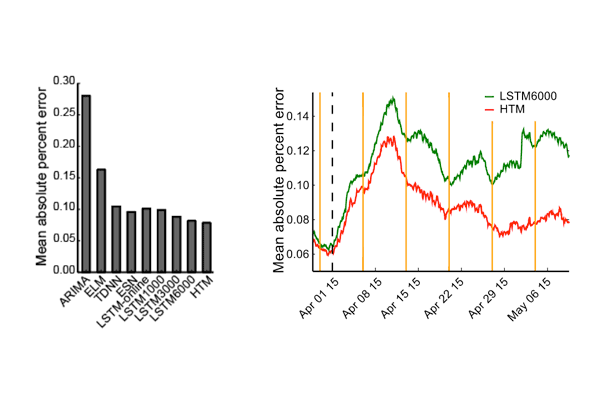| Authors | Y. Cui, S. Ahmad, & J. Hawkins |
| Journal | Neural Computation 28, 2474–2504 (2016) |
| Online | Read or Download this Paper |
| Published | November 1, 2016 |
This paper demonstrates how HTM sequence memory, a theoretical framework for sequence learning in the cortex, helps us understand how the brain can solve sequence learning problems and how we can apply this understanding to real-world sequence learning problems with continuous data streams. In this paper, we show how various properties of HTM sequence memory are applied to sequence learning and prediction on streaming data. We then show comparisons between HTM sequence memory and other sequence learning algorithms. These include statistical methods, (autoregressive integrated moving average), feedforward neural networks (time delay neural network and online sequential extreme learning machine), and recurrent neural networks (long short-term memory and echo-state networks). HTM achieves comparable results while displaying several important properties like continuous online learning, the ability to handle multiple predictions, robustness to sensor noise and fault tolerance, and
good performance without the need for task-specific tuning.

We used HTM and other algorithms to predict taxi passenger count in the New York City.
LEFT: Overall prediction error for various algorithms.
RIGHT: After a new pattern is introduced (black dashed line), HTM quickly learns the new pattern and gives better prediction accuracy than LSTM due to its ability of continuous learning.
Frequently Asked Questions About This Research
Q. What was the purpose of this study?
The purpose of this study was to compare HTM sequence memory to other sequence learning algorithms. This is a companion paper to Why Neurons Have Thousands of Synapses, A Theory of Sequence Memory in Neocortex, which appeared in Frontiers in Neural Circuits, March 2016.
Q. What are the key takeaways?
HTM performs well, particularly with respect to some important properties that apply to both biological systems and real-world streaming applications:
- Continuous online learning
- Because continuous data streams often have dynamic statistics, the ability to recognize and learn new patterns quickly is important, yet this property has not been well studied in machine learning. Applying machine learning algorithms to continuous data stream analysis often requires compute and storage-intensive resources, due to the need to keep a buffered data set of past records and regular retraining. By contrast, online sequence learning algorithms should learn in one pass.
- Ability to handle multiple predictions
- When information is ambiguous or changing, sequence learning algorithms should be able to make multiple predictions simultaneously and evaluate each one’s likelihood as opposed to making a single prediction based on maximum likelihood.
- Robustness to sensor noise and fault tolerance
- Sequence learning involves dealing with noisy, inaccurate and often missing data. A good sequence learning algorithm should be able to learn regardless of noise or system faults.
- Good performance without the need for task-specific tuning
- While most machine learning algorithms require optimizing a set of hyperparamaters for each task, an ideal sequence algorithm should display good performance on a wide range of problems without task-specific tuning.
Q. How does this research differ from other studies?
This study focuses on performance comparisons with a wide variety of techniques using some of the above criteria.
Q. How were the simulations conducted?
For this paper, we wrote simulation code in Python to demonstrate various properties of sequence memory. We used the reference HTM implementation available in the open source project NuPIC.
Q. Can I replicate these simulations?
Yes! In keeping with Numenta’s open research philosophy, the source code for replicating the graphs in the paper can be found here. We also welcome questions and discussion about the paper on the HTM Forum.
Q. How does this paper make contributions in machine learning?
The HTM sequence memory algorithm is something that machine learning experts can test and incorporate into a broad range of applications.
Q. Where can I find out more?
The HTM Forum is a great resource for further questions and discussion on HTM theory. The authors of this paper are active participants in the forum.
Q. What is next for this research?
Although HTM is still at a very early stage compared to other traditional neural network models, it shows promising results on real-time sequence learning problems. We would like to explore other applications of HTM for future research. Potential research directions include solving high-dimensional sequence learning problems and online sequence classification problems with HTM.
